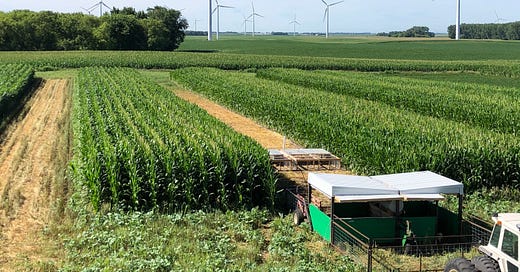Last year we visited Zack Smith’s Winnebago County farm to learn about innovation in conservation agriculture, and we thought it a good time to check back in and see how things went this harvest.
Zack gave up a coveted Pioneer seed dealership near Buffalo Center to dive whole-hog into his Stock Cropper system — a movable grazing pen powered by the sun that creeps through pasture forage in between stands of corn rows. Hogs, goats, cattle and chickens are escorted down the pasture lane in 20- and 30-foot pens guided by GPS, feeding on Nature’s finest forage and fertilizing it all the way.
Zack plants four rows of corn in a 10-foot strip, with a 10-foot strip of pasture next to it planted in succotash. Then he switches the strips the following year so the corn benefits from the year of grazing.
The results: 303 bushels per acre of corn over the field. He said he harvested 230 bushels of corn per acre in a conventional 30-inch arrangement. Plus, he benefits from greatly reduced commercial fertilizer costs and improved weed control. As he says, “I never saw goat-resistant water hemp.”
The young farmer has been interested for 10 years in wide-row spacing of corn for more efficient use of resources. He explains that by planting two rows at 60 to 90 inches apart makes more efficient use of sunlight, since there are only outside rows. Light can reach up and down the plant when it’s not crowded. He thinks 75-inch rows center-to-center might be the sweet spot, with a legume cover planted between to supply nitrogen.
Better exposure leads to “ginormous King Kong” main ears, Smith said, and some hybrids will throw off a second or third ear in wider rows down low. Ears fill out better with deeper kernels. Even without the Stock Cropper component in this test, Smith hauled in yields similar to his conventional corn.
With the Stock Cropper system fertilizing and building soil productivity, “If I could really focus on it I could get to 400 bushels, I think,” Smith said over the phone.
Plus, he has livestock to take to the butcher shop when the Stock Cropper shuts down for the season. It adds value to a small-farm operation.
He used some drought-resistant varieties this year that stood up well to a paucity of precipitation.
An autonomous livestock pen creeps through rows of corn in Winnebago County.
He is tinkering with the Stock Cropper and with different planting equipment to perfect his wide-row corn growing and grazing system. He works with farmers in Minnesota and Indiana on mechanical and crop system improvements, and holds field days and posts videos trying to spread the word about innovation in agriculture.
Smith is one of the more inventive among thousands of Iowa farmers trying new ways to survive or even thrive amid extreme weather and supply chains that hold producers captive.
Healthy soil combined with improved hybrids helped see him through a nasty drought with spectacular yields. And he did it while cutting herbicide and fertilizer costs.
“It’s all in the arrangement,” he says, explaining that you start to change systems when you arrange them differently. “You don’t need the airplane anymore to spray the fungicide because the corn canopy isn’t trapping that heat and moisture down low,” Zack says. “Wider rows open things up for air movement. You see?”
Every thing he says makes perfect sense when you are standing there looking at his gorgeous corn on a late summer’s day as I did in 2021. Now the numbers are backing him up. You can make more net revenue per acre by trying different ways than the ag-industrial complex has been preaching since the Eisenhower Administration.
What Zack is doing is not for everyone. But what he is doing — trying to conserve soil and water resources through diverse crop and livestock applications — holds keys to a healthier Iowa. It takes more people on the land and in town to raise hogs or chickens for butcher this way. It’s not crazy — what’s crazy is chasing a top-line yield and making less on every bushel through higher costs while suffocating the river.
Zack gets no government grant for his pilot project. He is pouring his own savings into building out his system, like legions of farm innovators before.
Zack Smith and so many others like him are a reason to think that we can address our climate, farm and food security issues through conservation agriculture. The numbers are pretty compelling. Three-hundred bushel corn per acre following a bunch of chickens and goats — all powered by the sun. Amazing.
Art Cullen is editor of the Storm Lake Times Pilot in Northwest Iowa, where this column appeared. For more columns and editorials, please consider a subscription to the Times Pilot. Or, if you wish, you can make a tax-deductible gift to the Western Iowa Journalism Foundation to support independent community journalism in rural Iowa. Thanks.
Check our all the great stuff through the Iowa Writers’ Collaborative. Here’s our current list:




Thanks for this interesting and informative story. I'm new to the Stock Cropper system, having missed coverage of your first visit with Zack Smith. Great to learn of his innovàtive farming practices!
Zack's you tube video should be watched by ISU ag classes. Credit to Art Cullen's column for inspiration on changing ag curricula. Stock cropping concept was also put in context at https://www.youtube.com/watch?v=5jaSQv0BjTE